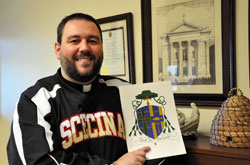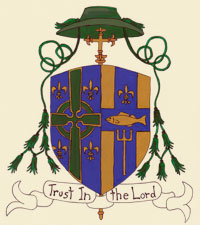Our New Auxiliary Bishop
Coat of arms features symbols of new bishop’s faith and family

Father Aaron Jenkins holds a copy of the coat of arms that he designed for Bishop-designate Christopher J. Coyne. Father Jenkins is the associate director of vocations for the archdiocese, chaplain of Father Thomas Scecina Memorial High School in Indianapolis, chaplain of the Indianapolis Fire Department, and sacramental minister of St. Maurice Parish in Napoleon, Immaculate Conception Parish in Milhousen and St. Denis Parish in Jennings County. (Photo by Mary Ann Wyand)
By Mary Ann Wyand
Green, blue and gold symbols—dominated by a large Celtic cross—form Bishop-designate Christopher J. Coyne’s episcopal coat of arms.
The new auxiliary bishop of the Archdiocese of Indianapolis blended images representing his love for God, family genealogy and ministry history in the Archdiocese of Boston on his shield.
Bishop-designate Coyne designed his coat of arms with Father Aaron Jenkins, a multimedia artist who serves as the associate director of vocations for the archdiocese as well as in several other pastoral ministries.
“He did a spectacular job,” the new bishop said of Father Jenkins’ artistry, which required knowledge of heraldry.
Their long-distance collaboration in recent weeks resulted in a beautiful coat of arms emblazoned with Irish and French symbols.
“Both of my grandmothers were French, while my grandfathers were Irish,” Bishop-designate Coyne explained. “The left-hand side of the coat of arms reflects those two heritages with the Celtic cross and the fleur de lis.
“The right-hand side of the crest is the insignia of the Archdiocese of Indianapolis for which I am to be ordained as an auxiliary bishop,” he said. “Above the shield is a processional cross taken from the insignia of the Archdiocese of Boston.”
The shield reflects his request for “a simple coat of arms,” he said, “that did not require too much explanation.”
Father Jenkins offered to design the crest as a gift to the new bishop.
“Before I became a priest, I was an art teacher,” Father Jenkins said. “Art is one of the things that brought me into the Church—our long and beautiful tradition of art in the Catholic Church—and ecclesiastical heraldry is something that I have always found fascinating. … Art is integral to who I am as a person in many ways. It’s also a prayer form for me. … Our God is a Creator God.”
Bishop-designate Coyne already had symbols in mind for his coat of arms, Father Jenkins said, when they began working together.
The dexter side of the shield is the higher place of honor so it is the personal part of the coat of arms, he said. The other side represents who he serves, and features the archdiocesan crest.
A bishop’s crest also must include a processional cross and six tassels on each side to show his ecclesiastical title or rank.
“They are simple symbols of his heritage,” Father Jenkins said. “My job from there was to take the symbols that he chose and put them into a design that is visually pleasing. I think [the crest] shows his desire to really be rooted in this place that God has sent him to now.” †
Definitions explain the parts of a bishop’s coat of arms
 Impalement—The joining of two coats of arms side by side.
Impalement—The joining of two coats of arms side by side.-
Dexter—The right-hand side of the shield, which is on the viewer’s left.
-
Sinister—While sinister means “left-handed,” on a coat of arms this is the right hand of the viewer. The right hand of the shield is the left hand of the viewer.
-
Azure in chief—Azure is a name for one shade of the color blue. The word comes from the Old French and Middle English languages.
-
Chief—The top of the shield.
-
Base—The bottom of the shield.
-
Sinister base quarter—The left-hand bottom quarter of the shield.
-
Dexter base quarter—The right-hand bottom quarter of the shield.
-
Charges—Figures on a colored field.
-
External embellishments—A type of ornamentation surrounding the shield, such as tassels. †

